
home
 |
Palästina
- Israel home |
PalisD |
|
My third visit to Gaza
April 21 to May 3, 2012 Peter Voss 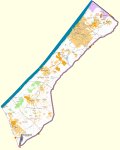 Gaza maps: 'OpenStreetMap', 'destruction'; 'no-go'; 'satellite': Google Earth oder Google Maps, else (28 MB) My last day and
supplements
This year, the stay in Gaza again affected my health. I developed a
kind of bronchitis, probably from an underlying asthma. It also had an
effect on my appetite. I felt increasingly uncomfortable and I found it
hard to speak. Since the last scheduled days fell into a weekend, I
decided to end my stay three days earlier, i.e. to shorten it to 10
days.Tents of prisoners On the last day there were still some farewell visits and phone calls. In the afternoon I went over to the place of the unknown soldier, where we had attended a rally last year. This year, the 'tents of the prisoners' were erected there, tents with men and women who fasted in solidarity with the hunger strikers in Israeli jails. I met with Shahd, two of her sisters and one of her brothers. I got to know Shahd properly only this year, although she was my carer, or better my watchdog last year at the demonstration. I mention Shahd here by name because she operates a blog (http://palestinefrommyeyes.wordpress.com) under her full name. Although she is still very young, she has a lot to report from personal experience, and through her blog I learned that her father, whom I had met as well as her mother a few days earlier, was released 27 years ago in a prisoner exchange. He had served 15 years of a seven times life sentence. It is strange feeling for me, when I consider that all these well-bred children I have met owe their existence to such an event. On the square of the unknown soldier several tents were set up, a larger one, in which the men fasting in solidarity stayed and a smaller one, in which the fasting women resided during the day. In between a larger number of billboards.  To the left from the center of the image the women's tent. The men's tent was located further to the right. 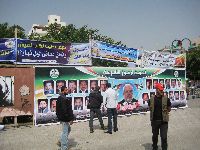
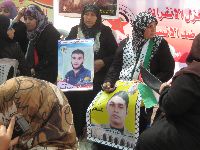

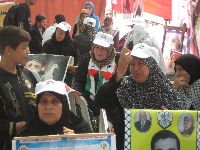 Billboard and women in the women's tent. The fasting women wore white hats. 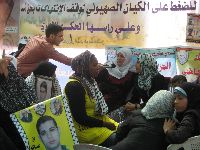 An interview with Hana Shalabi. Before her Samach, who became known a year ago as belonging to the group "Gaza Youth Breaks Out (GYBO)". On 3/30/12 there was a program on ARTE-TV about Hana Schalabi with the following introductory text: "The end
of the imprisonment for Hana Schalabi?
After 44 days of hunger strike in Israeli custody the Palestinian prisoner Hana Shalabi will be released to the Gaza Strip. Administrative detention Her case has attracted international attention: Shalabi is an activist in the militant Palestinian organization Islamic Jihad and had been released only in October as part of the large prisoner exchange between Israel and the radical Islamic Palestinian organization Hamas. On February 16, she was, however, taken back into administrative detention. It is a tool that Israel uses to imprison suspects indefinitely without charge and without notice. Symbol Shalabi Now the 30-year-old Shalabi, who comes from a village in the West Bank, has agreed to be discharged to the Gaza Strip. She is also accepting food again, the Israeli authorities stated. Human rights groups had assessed her condition lately as life-threatening. Already in the past Israel has deported Palestinians from the West Bank to Gaza (some even abroad), e.g. the defenders of the Church of the Nativity during the second intifada. They were to be allowed to return after a few years. This commitment was not respected by Israel. At the men's tent, I met Shahd and her siblings. Shahd introduced me to one of the prisoners released in the prisoner exchange. He had spent 24 years in Israeli captivity. I did not try to talk to him. 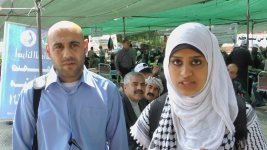
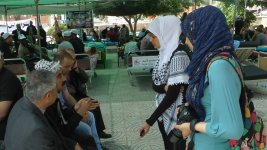 We were digressing from this topic anyway because I mentioned that in the second part of the exchange a lot of hopes were disappointed, because instead of releasing political prisoners, the Israelis released some criminals who did not have long sentences and had already served most of them (the family of the farmer in Salfit, which I had helped during the olive harvest in 2004 for the first time, had hoped in vain that one of her sons would be freed. As a 21-year-old police officer he got three life sentences for passing on his gun). Shahd was visibly irritated about what I had said, and took consultation with the freed man, who assured her that all of them were just political prisoners. In the left photo Shahd was just in the process of making this clear to me into the camera. A fasting man who had listened to our conversation intervened and explained to Shahd that there was probably some truth to my story. We then discussed for a while. It was obviously not easy for Shahd to accept that the main aspect of this issue was not Palestinian heroism but rather the perfidious trickery of the occupying power. The whole world had noticed what was going on. 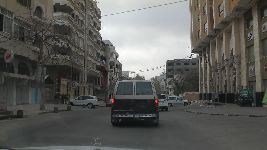
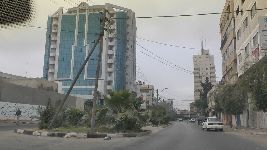
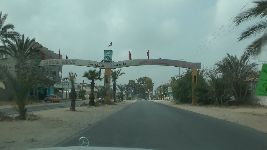
Early the next morning I went by taxi through the deserted streets of Gaza City toward Rafah. At Salah Al Deen Street there was a farewell salute from the welcome arch of Khan Younis. Supplements
What causes young Palestinians to expose themselves to sniper fire during demonstrations? In 2011 I spent a lot of time in the 'Gallery' open air restaurant with the Italian group of Vik2Gaza visitors. After nightfall there were some concerts and film screenings. One evening, a film was shown about the Nakba. If I remember right, there were mainly testimonies of witnesses. The film had no subtitles. With the help of a translator I was asked by the two producers of the film, whether I would be interested in this film. I told them that this would not be the case because I believed that the interest in such a movie in Germany would be very limited. Spontaneously another topic occurred to me. I asked them whether they would be able to produce a movie about the background of the demonstration that had just taken place on May 15. About 60 demonstrators were shot by the Israelis, and two were killed - as far as I could see all of them young people. How is it that no one prevented these young people from going there? What role was played by the parents, primarily probably the fathers? How did the Palestinian police act? What drove the youths to expose themselves to such danger? It appeared to be possible to generate such a movie. After my return to Germany, though, it very quickly became apparent that it was extremely difficult to maintain a contact even with the translator, and I never had any connection with the movie people. During my current visit I had no intention to pick up this issue and did not try to make contact. When I came home this year, I searched the Internet for current ISM (International Solidarity Movement) reports and came across one written under the pseudonym Johnny Bravo that accurately answered my questions. When I was in Gaza I did not know that Johnny was a pseudonym. During part of my time in Gaza he lived in the same house, and we often spent the evenings with others from the ISM staff in various restaurants. He lived in the same apartment as Nathan Stuckey, an ISM veteran, whom I had met a year earlier, and who at the time marched in the front line during the demonstration at Erez. Some time previously he had been injured seriously by an Israeli bullet. During my stay this year the ISM people accompanied farmers to their fields near the no-go zone. Johnny told me that there was hardly a day where there were no bullets whistling around their ears. These were shots that were obviously aimed at driving them out of of there. "They shoot the youth don't they?", 04/04/2012 Nasser's house On 07/16/2010, the Guardian reported under the heading "Mother of five killed by Israeli artillery fire close to Gaza buffer zone" about an Israeli attack on a house near the death strip on 07/13/10. The mother was killed by arrow ammunition (flechettes), which was fired by a tank, as she tried to rescue her two year old child from the fire zone during the shelling. The newspaper reported that the attack took place in the evening darkness out of the blue. There were no rockets fired from the area. The whole side of the house was riddled with arrows. Several family members were also injured. The rest of the family moved into tents behind the house and used the house only during the day. On 04/28/2011, the house was then bombarded with shells, that destroyed a portion of the upper floor completely. Miraculously the children who were staying in an immediately adjacent part of the upper floor survived. In the reports the place were this occurred was described as Johr ad Dik or Juhr ad Dik, a village in about the middle of the Gaza Strip, which had been destroyed almost completely during the Israeli assault of the year 2008/2009. It was not clear to me how to classify the subsequent bombardment of the Nasser family home in this context. As it turned out, the family was well known to the ISM volunteers. With their help I could have visited the family. I contented myself with having the directions to the place explained to me by Hussein, one of the local ISM supporters. There was a video on 01/30/2012 with Hussein interviewing Nasser (Gaza strip: life and death in the "buffer zone"). This is my current state of knowledge about Nasser's family and his home: 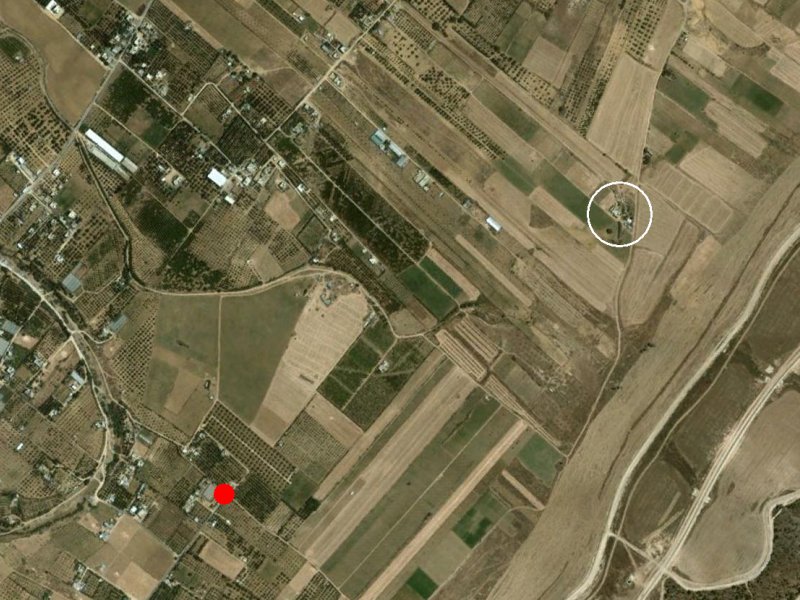 On the satellite image from 2007 the house is encircled in white. It is located about 350 meters away from the armistice line, with a few other houses nearby. The red dot marks the spot from which in 2010 I filmed the death strip 'east' of Al-Burej. The arch on the left side is the wadi. 
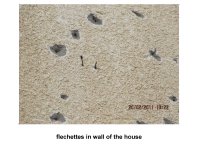 The first picture is taken from a report by OCHA. It shows the house littered with flechette strikes in August 2010. The cover of the United Nations 'Monthly Humanitarian Monitor' of the same month shows the condition of the house in April 2011 , the third image is a close-up photo of the arrows sticking in the wall (Vera Macht, Visiting Nasser, in German, see also). The following photos (I cannot find the source any more) show the landscape, the house in about the present condition, Nasser with his new wife and his children and the tent accommodation. 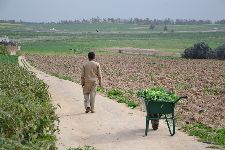 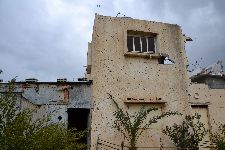 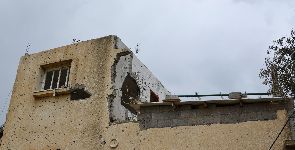 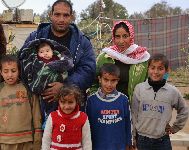  The family has a new offspring. They got some money from the UN, apparently not in order to repair the upper floor of the house but for a small new building (see video). Sooner or later they will move into the replacement home. At night they will listen to the gunfire and to the artillery thunder and pray. If they are lucky, the children will grow up healthy and eventually go their separate ways. Can we hope for them? back to part 1
|